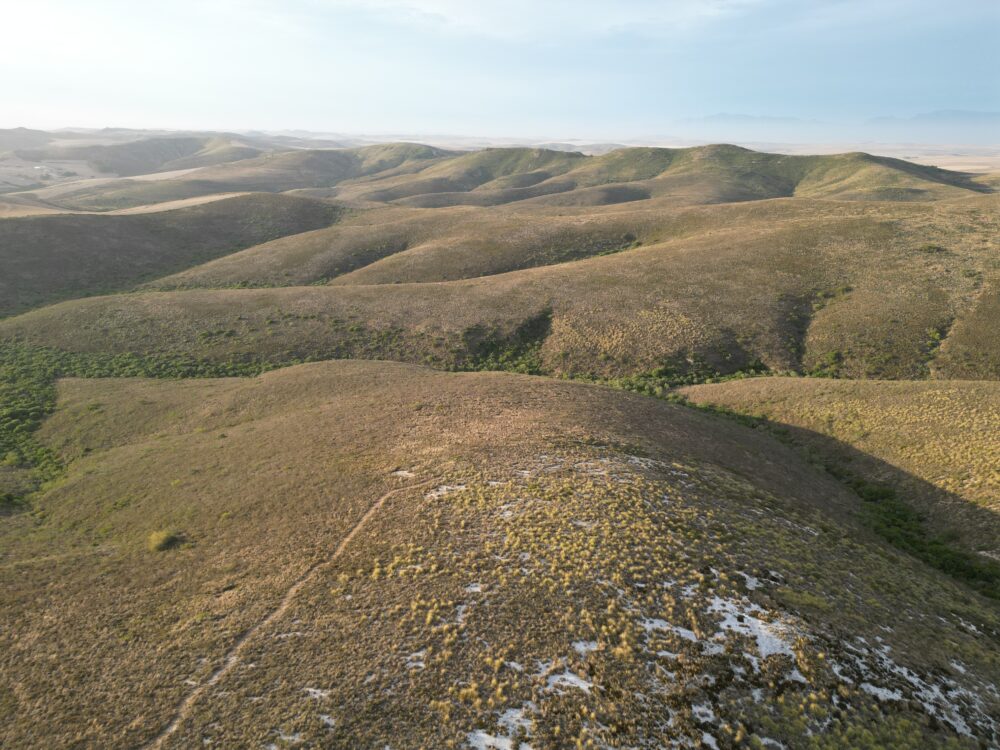A 270-hectare stretch of renosterveld has been secured for conservation in the Overberg, safeguarding a global stronghold for the endangered black harrier.
A 270-hectare stretch of renosterveld — one of South Africa’s most threatened vegetation types — has been secured for conservation in the Overberg, safeguarding a global stronghold for the endangered black harrier.
The Overberg Renosterveld Trust (ORT), in partnership with the UK-based World Land Trust and the Mapula Trust, has purchased a portion of the property Goereesoe, situated between Bredasdorp and Swellendam.
The site protects some of the last surviving fragments of Eastern Rûens shale renosterveld, home to an extraordinary diversity of endemic plants and one of the most important breeding sites for the black harriers that soar above them. Fewer than 500 breeding pairs remain worldwide.
“This is a significant win for renosterveld and the black harrier,” said Odette Curtis-Scott, the chief executive of the ORT, a conservation organisation dedicated to protecting and restoring the Overberg’s remaining pockets of renosterveld.
“Goereesoe has the highest known density of black harrier nests in a single year. By securing this land, we are protecting critical habitat and species whose futures are teetering on a knife edge.”
The property supports up to 20 breeding pairs of black harriers. According to Curtis-Scott, that so many pairs are breeding on only 270-hectares is “unheard of”.
Together with neighbouring reserves Haarwegskloof and Plaatjieskraal — both managed by the Overberg Renosterveld Trust — this cluster sustains about 30 breeding pairs, or 6% of the global population of the iconic raptor.

The chief executive of the World Land Trust, Catherine Barnard, said of the acquisition: “Protecting this site means safeguarding one of the most threatened ecosystems on Earth, and the species that depend on it. It’s a culmination of a lot of hard work from Odette and the ORT team.”
Once widespread, renosterveld has been decimated by agriculture, with only about 5% of the Overberg’s original extent remaining. Each patch holds unique biodiversity that includes rare bulbs and flowering plants to wildlife.
The Goereesoe purchase expands the Haarwegskloof Cluster, the largest connected stretch of renosterveld left on Earth. The cluster has grown from 500 hectares in 2013 to more than 1 300 hectares today, thanks to the addition of Plaatjieskraal and Goereesoe, both earmarked for nature reserve status.
“With the number of black harrier breeding on Goereesoe, this achievement has become a jewel in the crown for the ORT,” Curtis-Scott said.
The Overberg Renosterveld Trust is also building conservation corridors with farming neighbours, including the nearby Muurkraal Conservation Easement site.
“It means wildlife, especially our precious pollinators and invertebrates, can move freely and safely across natural remnant patches in this highly transformed landscape,” she said. “Our ultimate goal is to protect as much of the remaining biodiversity as possible, building ecological resilience to future land-use change and climate change.”
Goereesoe’s protection was made possible through the World Land Trust “buy an acre” programme, which enables people worldwide to fund land purchases for threatened habitats.
But land acquisition is just one tool. The trust also drives a conservation easement programme, where landowners voluntarily place conservation servitudes on their properties.
“Together, these tools are vital for conservation in highly fragmented ecosystems such as renosterveld,” Curtis-Scott noted. “Our work centres on instilling a sense of pride among landowners who have renosterveld on their farms, as they literally hold its future in their hands.”
Goereesoe is also central to ongoing black harrier tracking studies, monitoring their movements across South Africa, Lesotho and Namibia, and assessing the effect of wind farms, which are emerging as a threat to the bird species.
There are only an estimated 1 300 individual black harriers left, with an annual decline of at least 2%, Curtis-Scott said.
“Long-term, with additional wind power coming in, and causing extra pressure on the birds — which have already lost so much habitat — conserving these critical breeding areas is crucial for the species,” she said.
“It’s a valuable site from a breeding and studying perspective for them. For us, the trackers that we’re putting on the birds, the GPS tagging that we’re doing, learning about their behaviour around wind farms and how much of a threat that places on them.”
She noted that the biggest threat to what’s left of the renosterveld is further ploughing.
“Basically, all the best lands have already been ploughed and a whole lot of land that turned out to be not so optimal, so in other words, what the farmers call C-grade lands, that should never have been ploughed.
“One of the biggest problems is that sometimes the little stepping stones, or small corridors [of renosterveld], get in the way of the ever-increasing mechanical implements that are used for farming … So these little patches are getting taken out … and then there’s of course, chemical drift … from surrounding croplands.”
The sites are also being used as dumpsites by landowners.
“Often they use the watercourses to dump their rubbish, their dead animals, chemical containers and rocks. The fact that these sites are viewed as a wasteland is what makes it so vulnerable to neglect and abuse,” Curtis-Scott said.
But, through the conservation easement programme, more than 4500ha has been signed with landowners.
“There are some amazing landowners in this landscape who want to conserve and who are doing a lot to help renosterveld but there are many challenges remaining,” she said.